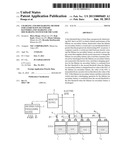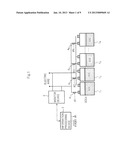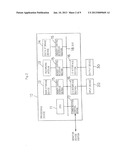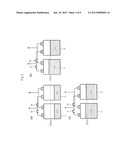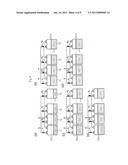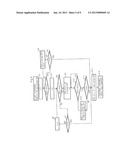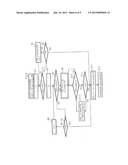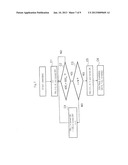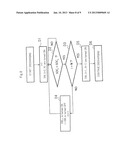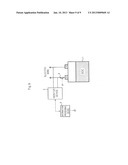Patent application title: CHARGING AND DISCHARGING METHOD FOR LITHIUM ION SECONDARY BATTERIES AND CHARGING AND DISCHARGING SYSTEM FOR THE SAME
Inventors:
Hiroo Hongo (Minato-Ku, JP)
Koji Kudo (Minato-Ku, JP)
Hisato Sakuma (Minato-Ku, JP)
Ryosuke Kuribayashi (Minato-Ku, JP)
Assignees:
NEC Corporation
IPC8 Class: AH02J700FI
USPC Class:
320134
Class name: Battery or cell discharging with charging with battery or cell condition monitoring (e.g., for protection from overcharging, heating, etc.)
Publication date: 2013-01-10
Patent application number: 20130009605
Abstract:
A first threshold that is lower than a progressively deteriorating SOC
that is an SOC in which a battery performance of the lithium ion
secondary battery deteriorates when the lithium ion secondary battery is
stored and a second threshold that is greater than the progressively
deteriorating SOC are preset. A computer controls a switch provided
between electric wires and the lithium ion secondary battery, an electric
power supply source that supplies electric power necessary to charge the
lithium ion secondary battery and a load that consumes electric power
discharged from the lithium ion secondary battery are connected to the
electric wires, such that a charging operation for the lithium ion
secondary battery is continued from the first threshold to the second
threshold when the lithium ion secondary battery is charged based on
value of the SOC of the lithium ion secondary battery, the value of the
SOC is transmitted from a monitor device that detects the value of the
SOC of the lithium ion secondary battery and that controls the switch
such that a discharging operation for the lithium ion secondary battery
is continued from the second threshold to the first threshold when the
lithium ion secondary battery is discharged.Claims:
1. A charging and discharging method for lithium ion secondary batteries
having a manganese positive electrode material, the method comprising the
steps of: causing a computer to store a preset first threshold that is
lower than a progressively deteriorating SOC that is an SOC in which
battery performance of said lithium ion secondary battery deteriorates
when the lithium ion secondary battery is stored and to store a preset
second threshold that is greater than said progressively deteriorating
SOC; causing said computer to control a switch provided between electric
wires and said lithium ion secondary battery, an electric power supply
source that supplies electric power necessary to charge said lithium ion
secondary battery and a load that consumes electric power discharged from
said lithium ion secondary battery that is connected to said electric
wires, such that a charging operation for said lithium ion secondary
battery is continued from said first threshold to said second threshold
when said lithium ion secondary battery is charged based on a value of
the SOC of said lithium ion secondary battery, the value of the SOC being
transmitted from a monitor device that detects the value of the SOC of
said lithium ion secondary battery; and causing said computer to control
said switch such that a discharging operation for said lithium ion
secondary battery is continued from said second threshold to said first
threshold when said lithium ion secondary battery is discharged.
2. The charging and discharging method for lithium ion secondary batteries according to claim 1, wherein when said plurality of lithium ion secondary batteries are charged, the first control step is performed by causing said computer to control said plurality of switches provided corresponding to said lithium ion secondary batteries such that said lithium ion secondary batteries that have reached said first threshold are successively charged from said first threshold to said second threshold, and wherein when said plurality of lithium ion secondary batteries are discharged, the second control step is performed by causing said computer to control said switches provided corresponding to said lithium ion secondary batteries such that said lithium ion secondary batteries that have reached said second threshold are successively discharged from said second threshold to said first threshold.
3. The charging and discharging method for lithium ion secondary batteries according to claim 1, wherein said positive electrode material of said lithium ion secondary batteries is mainly lithium manganese oxide.
4. A charging and discharging system that controls charging and discharging for lithium ion secondary batteries having a manganese positive electrode material, comprising: a monitor device that detects SOCs of said lithium ion secondary batteries; switches that connect or disconnect electric wires and said lithium ion secondary batteries, a power supply source that supplies electric power necessary to charge said lithium ion secondary batteries and a load that consumes electric power discharged from said lithium ion secondary batteries that are connected to said electric wires; and an information processing device that stores a preset first threshold that is lower than a progressively deteriorating SOC that is an SOC in which battery performance of said lithium ion secondary batteries deteriorates when the lithium ion secondary batteries are stored and a preset second threshold that is greater than said progressively deteriorating SOC and that controls said switches such that a charging operation for said lithium ion secondary batteries is continued from said first threshold to said second threshold when said lithium ion secondary batteries are charged and such that a discharging operation for said lithium ion secondary batteries is continued from said second threshold to said first threshold when said lithium ion secondary batteries are discharged based on values of the SOCs of said lithium ion secondary batteries, the values of the SOCs being detected by said monitor device.
5. The charging and discharging system according to claim 4, wherein said switches are provided corresponding to said lithium ion secondary batteries, wherein when said plurality of lithium ion secondary batteries are charged, said information processing device controls said switches such that said lithium ion secondary batteries that have reached said first threshold are successively charged from said first threshold to said second threshold, and wherein when said plurality of lithium ion secondary batteries are discharged, said information processing device controls said switches such that said lithium ion secondary batteries that have reached said second threshold are successively discharged from said second threshold to said first threshold.
6. The charging and discharging system according to claim 4, wherein said positive electrode material of said lithium ion secondary batteries is mainly lithium manganese oxide.
7. An information processing device that controls charging and discharging for lithium ion secondary batteries having a manganese positive electrode material, comprising: a storage device that stores a preset first threshold that is lower than a progressively deteriorating SOC that is an SOC in which battery performance of the lithium ion secondary batteries deteriorates when the lithium ion secondary batteries are stored and that stores a preset second threshold that is greater than said progressively deteriorating SOC; and a processing device that controls switches provided between electric wires and said lithium ion secondary batteries, an electric power supply source that supplies electric power necessary to charge said lithium ion secondary batteries and a load that consumes electric power discharged from said lithium ion secondary batteries that are connected to said electric wires, such that a charging operation for said lithium ion secondary batteries is continued from said first threshold to said second threshold when said lithium ion secondary batteries are charged and such that a discharging operation for said lithium ion secondary batteries is continued from said second threshold to said first threshold when said lithium ion secondary batteries are discharged based on values of the SOCs of said lithium ion secondary batteries, the values of the SOCs being transmitted from a monitor device that detects the values of the SOCs of said lithium ion secondary batteries.
8. The information processing device according to claim 7, wherein when said plurality of lithium ion secondary batteries are charged, said information processing device controls said switches provided corresponding to said lithium ion secondary batteries such that said lithium ion secondary batteries that have reached said first threshold are successively charged from said first threshold to said second threshold, and wherein when said plurality of lithium ion secondary batteries are discharged, said information processing device controls said switches provided corresponding to said lithium ion secondary batteries such that said lithium ion secondary batteries that have reached said second threshold are successively discharged from said second threshold to said first threshold.
9. The information processing device according to claim 7, wherein said positive electrode material of said lithium ion secondary batteries is mainly lithium manganese oxide.
Description:
TECHNICAL FIELD
[0001] The present invention relates to a charging and discharging method for lithium ion secondary batteries having a manganese positive polarity material and a charging and discharging system for the same.
BACKGROUND ART
[0002] Since lithium ion secondary batteries that bind and give off lithium ions have advantages such as high energy densities, high operating voltages, and so forth over nickel cadmium (Ni--Cd) batteries and nickel metal hydride (Ni--MH) batteries of the same capacities, they have been widely used for information processing devices and communication devices such as personal computers and mobile phones that require miniaturization and lightweightness.
[0003] Moreover, in recent years, lithium ion secondary batteries have been assessed to be usable as power supplies for electric bicycles, hybrid automobiles, and so forth and also they are being introduced as batteries that store electric power generated by renewable power supplies such as solar batteries to accomplish a low-carbon society that solves global warming problems.
[0004] To enable the widespread use of lithium ion secondary batteries as electric power storage and as a high capacity power supply for electric automobiles, it is necessary to reduce the maintenance cost as well as manufacturing cost, thereby to prolong their product lives.
[0005] Although it is thought that the product life of lithium ion secondary batteries can be extended by re-evaluating the materials that comprise them and the structure of the batteries, there is a method that can reduce the shortening of their product life cycles that is caused by inappropriate usage of the battery and so forth. For example, Patent Literature 1 and Patent Literature 2 propose techniques that reduce the shortening of the life cycles of lithium ion secondary batteries by controlling charging and discharging of these batteries.
[0006] Patent Literature 1 presents that charging and discharging of a lithium ion secondary battery are controlled such that the number of lithium ions that migrate between a positive electrode material and a negative electrode active material when the lithium ion secondary battery is charged or discharged is 95% or less of the number of lithium ions that migrate in the reverse direction. On the other hand, Patent Literature 2 presents that charging and discharging of a lithium ion secondary battery are controlled such that the end-of-discharge voltage when the lithium ion secondary battery is discharged ranges from 3.2 to 3.1 V and such that the upper limit voltage when the lithium ion secondary battery is charged ranges from 4.0 to 4.5 V.
[0007] As positive electrode materials (positive electrode active materials) of lithium ion secondary batteries, compositions using lithium cobalt oxide, lithium manganese oxide, and lithium nickel oxide are known. As negative electrode materials (negative electrode active materials), compositions using graphites and cokes are known.
[0008] The applicant of the present patent application discovered that when a manganese lithium ion secondary battery having lithium manganese oxide that is used for the positive electrode material of various types of lithium ion secondary batteries is stored in a particular SOC (State of Charge), the battery performance quickly deteriorates.
[0009] In this context, SOC represents the ratio of the capacity of the lithium ion secondary battery to the amount of electric charge. The particular SOC in which the battery performance quickly deteriorates is less than the maximum SOC that is the charging limit point and greater than the minimum SOC that is the discharging limit point, for example SOC=40%. In addition, "store" in the specification of the present patent application denotes that a lithium ion secondary battery is kept in the state of a particular voltage of the SOC.
[0010] The phenomenon in which the battery performance deteriorates in the particular SOC is not significantly related to a case in which the lithium ion secondary battery is stored in the fully charged state, for example, when it is used for a UPS (Uninterruptible Power Supply).
[0011] However, in an application where a lithium ion secondary battery is stored in any SOC between the maximum SOC and the minimum SOC, for example in an application where electric power generated by the above-described renewable power supply is stored, the lithium ion secondary battery can be understood as being kept in the above-described particular SOC. In such a case, the battery performance of the lithium ion secondary battery will quickly deteriorate.
RELATED ART LITERATURE
Patent Literature
[0012] Patent Literature 1: Japanese Patent Laid-Open No 2000-030751
[0013] Patent Literature 2: Japanese Patent Laid-Open No 2001-307781
SUMMARY
[0014] Therefore, an object of the present invention is to provide a charging and discharging method for manganese lithium ion secondary batteries and a charging and discharging system for the same that can reduce a shortening of the life cycle of manganese lithium ion secondary batteries when they are stored.
[0015] To accomplish the above-described object, a charging and discharging method for lithium ion secondary batteries according to an exemplary aspect of the present invention is a charging and discharging method for lithium ion secondary batteries having manganese positive electrode material, the method comprising the steps of:
[0016] causing a computer to store a preset first threshold that is lower than a progressively deteriorating SOC that is an SOC in which a battery performance of said lithium ion secondary battery deteriorates when the lithium ion secondary battery is stored and a preset second threshold that is greater than said progressively deteriorating SOC;
[0017] causing said computer to control a switch provided between electric wires and said lithium ion secondary battery, an electric power supply source that supplies electric power necessary to charge said lithium ion secondary battery and a load that consumes electric power discharged from said lithium ion secondary battery being connected to said electric wires, such that a charging operation for said lithium ion secondary battery is continued from said first threshold to said second threshold when said lithium ion secondary battery is charged based on value of the SOC of said lithium ion secondary battery, the value of the SOC being transmitted from a monitor device that detects the value of the SOC of said lithium ion secondary battery; and
[0018] causing said computer to control said switch such that a discharging operation for said lithium ion secondary battery is continued from said second threshold to said first threshold when said lithium ion secondary battery is discharged.
[0019] On the other hand, a charging and discharging system according to an exemplary aspect of the present invention is a charging and discharging system that controls charging and discharging for lithium ion secondary batteries having manganese positive electrode material, comprising:
[0020] a monitor device that detects SOCs of said lithium ion secondary batteries;
[0021] switches that connect or disconnect electric wires and said lithium ion secondary batteries, a power supply source that supplies electric power necessary to charge said lithium ion secondary batteries and a load that consumes electric power discharged from said lithium ion secondary batteries that is connected to said electric wires; and
[0022] an information processing device that stores a preset first threshold that is lower than a progressively deteriorating SOC that is an SOC in which battery performance of said lithium ion secondary batteries deteriorates when the lithium ion secondary batteries are stored and a preset second threshold that is greater than said progressively deteriorating SOC and controls said switches such that a charging operation for said lithium ion secondary batteries is continued from said first threshold to said second threshold when said lithium ion secondary batteries are charged and that a discharging operation for said lithium ion secondary batteries is continued from said second threshold to said first threshold when said lithium ion secondary batteries are discharged based on values of the SOCs of said lithium ion secondary batteries, the values of the SOCs being detected by said monitor device.
BRIEF DESCRIPTION OF DRAWINGS
[0023] FIG. 1 is a block diagram exemplifying a charging and discharging system according to a first exemplary embodiment.
[0024] FIG. 2 is a block diagram exemplifying an information processing device shown in FIG. 1.
[0025] FIG. 3 is a schematic diagram showing a controlling method performed by the charging and discharging system according to the first exemplary embodiment.
[0026] FIG. 4 is a schematic diagram showing the controlling method performed by the charging and discharging system according to the first exemplary embodiment.
[0027] FIG. 5 is a flow chart exemplifying a charging procedure of a charging and discharging method based on which lithium ion secondary batteries are charged according to the first exemplary embodiment.
[0028] FIG. 6 is a flow chart exemplifying a discharging procedure of the charging and discharging method based on which the lithium ion secondary batteries are discharged according to the first exemplary embodiment.
[0029] FIG. 7 is a flow chart further exemplifying the charging procedure of the charging and discharging method based on which the lithium ion secondary batteries are charged according to the first exemplary embodiment.
[0030] FIG. 8 is a flow chart further exemplifying the discharging procedure of the charging and discharging method based on which the lithium ion secondary batteries are discharged according to the first exemplary embodiment.
[0031] FIG. 9 is a block diagram exemplifying a charging and discharging system according to a second exemplary embodiment.
EXEMPLARY EMBODIMENT
[0032] Next, with reference to drawings, the present invention will be described.
First Exemplary Embodiment
[0033] FIG. 1 is a block diagram exemplifying a charging and discharging system according to the first exemplary embodiment, whereas FIG. 2 is a block diagram exemplifying an information processing device shown in FIG. 1.
[0034] As shown in FIG. 1, the charging and discharging system according to the first exemplary embodiment is structured to provide N (where N is a positive integer) lithium ion secondary batteries (hereinafter simply referred to as secondary batteries) 11 to 1N whose positive and negative electrodes are connected in parallel to corresponding electric wires), monitor device 2 that detects the values of the SOCs of individual secondary batteries 11 to 1N, information processing device 3 that controls charging and discharging of secondary batteries 11 to 1N, and a plurality of switches 41 to 4N that are provided corresponding to secondary batteries 11 to 1N and that respectively connect or disconnect secondary batteries 11 to 1N and the electric wires.
[0035] Connected to the electric wires are an electric power supply source that supplies electric power necessary to charge the secondary batteries, for example a renewable electric power supply that an electric power user (residence or facility) provides, and a terminal voltage transformer that distributes electric power supplied from a distribution substation of an electric power company to each electric power user. In addition, a load that consumes electric power discharged from the secondary batteries, for example, one of various types of electric devices and a certain type of heat pump hot water supplier that the electric power user (residence or facility) provides and that consumes electric power.
[0036] Although FIG. 1 shows that N secondary batteries 11 to 1N are closely arranged, they may be arranged in any manner as long as their charging and discharging can be controlled. For example, a plurality of secondary batteries (cells) 11 to 1N may be contained in one package (battery pack) or secondary batteries 11 to 1N may be distributed for electric power storage of individual electric power users (residences or facilities) who live or that exist in remote areas. If secondary batteries 11 to 1N are distributed separately from each other, a connection between information processing device 3 and monitor device 2 and connections between information processing device 3 and switches 41 to 4N can be made through a known information communication means such that information, commands and so forth can be transmitted and received. As the information communication means, a known wireless communication means or a known wired communication means can be used. The wireless communication means can be considered appropriate for a known Zigbee wireless system that uses for example a 950 MHz band radio frequency. The wired communication means can be considered appropriate for a known PLC (Power Line Communication) system that transmits and receives information through electric wires. The charging and discharging system according to this exemplary embodiment can be connected to any system as long as this system can supply predetermined electric power to secondary batteries 11 to 1N when these batteries are charged and supply electric power to one of various types of electric devices (load) when these batteries are discharged.
[0037] As described above, secondary batteries 11 to 1N are manganese lithium ion secondary batteries. Manganese lithium ion secondary batteries are batteries whose positive electrode materials are mainly lithium manganese oxide (LixMnyO.sub.z: x is around 1 or around 0.65 or around 0.1 to 0.5; y is around 2; z is around 4). However, the compositional ratio of Li, Mn, and O is not limited to those values. In addition, the positive electrode material may contain various types of substances such as Al, Mg, Cr, Fe, Co, Ni, and Cu as long as the positive electrode material is mainly lithium manganese oxide.
[0038] Dotted lines over secondary batteries 11 to 1N shown in FIG. 1 represent the particular SOCs in which the performance of secondary batteries 11 to 1N quickly deteriorates when they are stored (hereinafter referred to as the progressively deteriorating SOCd). On the other hand, solid lines over secondary batteries 11 to 1N shown in FIG. 1 schematically represent the quantity of stored electricity compared to the capacities of secondary batteries 11 to 1N. Those legends apply to dotted lines and solid lines of secondary batteries shown in FIG. 3, FIG. 4, and FIG. 7. Although FIG. 1 exemplifies that the capacities of secondary batteries 11 to 1N are the same, they may differ from each other.
[0039] Switches 41 to 4N are for example MOSFETs (Metal Oxide Semiconductor Field Effect Transistors) that can turn on/off relatively large amounts of electric power and that can be easily controlled. Switches 41 to 4N are connected to information processing device 3 that controls on/off of switches 41 to 4N. Switches 41 to 4N are provided with driving circuits that turn on/off their contacts. Switches 41 to 4N may be arranged in the vicinity of secondary batteries 11 to 1N or information processing device 3. The contacts of switches 41 to 4N are not necessary to be integrated with their driving circuits; instead, the contacts may be arranged in the vicinity of secondary batteries 11 to 1N and the driving circuits may be arranged in the vicinity of information processing device 3.
[0040] Monitor device 2 can be accomplished by a known charging device or protection device that is supplied by the manufacturer or supplier of secondary batteries 11 to 1N and that is manufactured based on the performance and characteristic of secondary batteries 11 to 1N. Generally, the protection device detects the SOCs of individual secondary batteries 11 to 1N and current values that are input to and output from secondary batteries 11 to 1N, whereas the charging device changes the charging current (constant current) and charging voltage (constant voltage) based on the SOCs and current values detected by the protection device. Normally, since the SOCs of secondary batteries 11 to 1N nearly correspond to their output voltages, monitor device 2 may detect the output voltage values of secondary batteries 11 to 1N instead of the SOCs. If the SOCs of secondary batteries 11 to 1N detected by monitor device 2 are analog values, monitor device 2 may be provided with an A/D converter that converts the values of the SOCs into digital values. The A/D converter may be provided in information processing device 3. Monitor device 2 may be structured to provide N detectors that individually detect SOCs of individual secondary batteries 11 to 1N or provide one detector that detects the values of the SOCs of secondary batteries 11 to 1N.
[0041] Information processing device 3 receives the values of the SOCs of secondary batteries 11 to 1N from monitor device 2 when they are charged and discharged and turns on/off switches 41 to 4N based on the received Values of the SOCs so as to control charging and discharging of individual secondary batteries 11 to 1N.
[0042] Information processing device 3 can be accomplished for example by a computer having the structure shown in FIG. 2. Information processing device 3 is not limited to the computer having the structure shown in FIG. 2. When information processing device 3 controls a battery pack that contains a plurality of cells, information processing device 3 can be realized by a microcomputer or the like that is composed of one or a plurality of ICs (Integrated Circuits).
[0043] The computer shown in FIG. 2 is structured to provide processing device 10 that executes a predetermined process according to a program, input device 20 that inputs commands, information, and so forth into processing device 10, and output device 30 that outputs a processed result of processing device 10.
[0044] Processing device 10 is structured to provide CPU 11, main storage device 12 that temporarily stores information that is necessary for a process that CPU 11 executes, recording medium 13 that has recorded a program that causes CPU 11 to execute a process according to the present invention, data storage device 14 that stores rating capacity, maximum SOC, and minimum SOC, first threshold SOCL, second threshold SOCU, and so forth of individual secondary batteries 11 to 1N (first threshold SOCL, second threshold SOCU will be described later), memory control interface section 15 that controls data transferred among main storage device 12, recording medium 13, and data storage device 14, I/O interface section 16 that is an interface device between input device 20 and output device 30, and communication control device 16 that transmits and receives information and commands between monitor device 2 and switches 41 to 4N and those devices that are connected through bus 18.
[0045] Processing device 10 executes a procedure that will be described later according to the program recorded on recording medium 13 so as to control charging and discharging of individual secondary batteries 11 to 1N. Recording medium 13 may be a magnetic disk, a semiconductor memory, an optical disc, or another type of recording medium. On the other hand, data storage device 14 may or may not to be provided in processing device 10, it can be provided by an independent device.
[0046] Next, with reference to FIG. 3 and FIG. 4, the theory of the operation of the charging and discharging system according to this exemplary embodiment will be described.
[0047] FIG. 3(a) to (e) and FIG. 4(a) to (e) are schematic diagrams showing a controlling method performed by the charging and discharging system according to the first exemplary embodiment. FIG. 3(a) to (e) exemplify that charging and discharging of two secondary batteries 11 and 12 connected in parallel are controlled, whereas FIG. 4(a) to (e) exemplify that charging and discharging of a plurality of secondary batteries 11 to 1N connected in parallel are controlled.
[0048] The charging and discharging system according to this exemplary embodiment controls secondary batteries 11 to 1N such that the charging operation or discharging operation does not stop in the progressively deteriorating SOCd of each of secondary batteries 11 to 1N. Specifically, the first threshold SOCL that is less than progressively deteriorating SOCd of each of secondary batteries 11 to 1N and the second threshold SOCU that is greater than the progressively deteriorating SOCd are pre-set. The first threshold SOCL and the second threshold SOCU can be preset depending on the progressively deteriorating SOCd of individual secondary batteries 11 to 1N by the manufacturer, supplier, or user thereof and can be pre-stored in data storage device 14 of information processing device 3.
[0049] According to this exemplary embodiment, two secondary batteries 11 and 12 are charged as shown in FIG. 3(a) to (c) such that two secondary batteries 11 and 12 are simultaneously charged until they reach the above-described progressively deteriorating SOCd, that when the values of the SOCs of two secondary batteries 11 and 12 have reached the first threshold SOCL, only secondary battery 11 is charged from the first threshold SOCL to the second threshold SOCU, then only the other secondary battery 12 is charged from the first threshold SOCL to the second threshold SOCU and then two secondary batteries 11 and 12 are simultaneously charged again.
[0050] On the other hand, two secondary batteries 11 and 12 are discharged such that they are simultaneously discharged until the values of the SOCs reach the above-described progressively deteriorating SOCd, that when the values of the SOCs of two secondary batteries 11 and 12 have reached the second threshold SOCU, only one secondary battery 11 is discharged from the second threshold SOCU to the first threshold SOCL, then only the other secondary battery 12 is discharged from the second threshold SOCU to the first threshold SOCL, and then two secondary batteries 11 and 12 are simultaneously discharged again.
[0051] FIG. 3(a) shows that two secondary batteries 11 and 12 are simultaneously being charged. In addition, FIG. 3(a) exemplifies that the values of the SOCs of two secondary batteries 11 and 12 that are being charged are the same. FIG. 3(b) shows that the values of the SOCs of two secondary batteries 11 and 12 have reached the first threshold SOCL from the state shown in FIG. 3(a), that the charging operation for secondary battery 12 on the right side is stopped, and then only secondary battery 11 on the left side is charged to the second threshold SOCU. FIG. 3(c) shows that after the state shown in FIG. 3(b), the charging operation for secondary battery 11 on the left side is stopped and then only secondary battery 12 on the right side is charged to the second threshold SOCU.
[0052] On the other hand, three or more secondary batteries 11 to 1N as shown in FIG. 4(a) to (e) are charged such that individual secondary batteries 11 to 1N are simultaneously charged until the values of their SOCs reach the above-described progressively deteriorating SOCd, that when the values of the SOCs of secondary batteries 11 to 1N have reached the first threshold SOCL, individual secondary batteries 11 to 1N are successively charged from the first threshold SOCL to the second threshold SOCU, and then individual secondary batteries 11 to 1N are simultaneously charged again.
[0053] On the other hand, three or more secondary batteries 11 to 1N are discharged such that secondary batteries 11 to 1N are simultaneously discharged until the values of their SOCs reach the above-described progressively deteriorating SOCd, that when the values of the SOCs of secondary batteries 11 to 1N have reached the second threshold SOCU, individual secondary batteries 11 to 1N are successively discharged from the second threshold SOCU to the first threshold SOCL, and then individual secondary batteries 11 to 1N are simultaneously discharged again.
[0054] FIG. 4(a) shows that a plurality of secondary batteries 11 to 1N are being simultaneously charged. In addition, FIG. 4(a) exemplifies that the values of the SOCs of individual secondary batteries 11 to 1N that are being charged are the same. FIG. 4(b) shows that after the state shown in FIG. 4(a), the values of the SOCs of individual secondary batteries 11 to 1N have reached the first threshold SOCL, the charging operation for all secondary batteries 12 to 1N other than secondary battery 11 on the leftmost side is stopped, and that then only secondary battery 11 on the leftmost side is charged until the value of the SOC reaches the second threshold SOCU. FIG. 4(c) shows that after the state shown in FIG. 4(b), the charging operation for all secondary batteries 11 and 13 to 1N other than secondary battery 12 at the second leftmost position is stopped, and that then only secondary battery 12 at the second leftmost position is charged until the value of the SOC reaches the second threshold SOCU. FIG. 4(d) shows that after the state shown in FIG. 4(c), the charging operation for all secondary batteries 11 to 1N-1 other than secondary battery 1N on the rightmost side is stopped and that then only secondary battery 1N on the rightmost side is charged until the value of the SOC reaches the second threshold SOCU. FIG. 4(e) shows that after the state shown in FIG. 4(d), the charging operation for individual secondary batteries 11 to 1N is simultaneously started again.
[0055] As shown in FIG. 3(a) to (c) and FIG. 4(a) to (e), the charging operation and discharging operation for individual secondary batteries 11 to 1N can be controlled by causing switches 41 to 4N to connect or disconnect the electric wires and secondary batteries 11 to 1N.
[0056] Although the above description, FIG. 3(a) to (c), and FIG. 4(a) to (e) exemplify that when the charging operation and discharging operation are started, the values of the SOCs of individual secondary batteries 11 to 1N are the same, when the charging operation and discharging operation are started, the values of the SOCs of individual secondary batteries 11 to 1N may be different from each other. In this case, in the order that the values of the SOCs of secondary batteries 11 to 1N have reached the first threshold SOCL, they can be successively charged from the first threshold SOCL to the second threshold SOCU. Likewise, in the order that the values of the SOCs of secondary batteries 11 to 1N have reached the second threshold SOCU, they can be successfully discharged from the second threshold SOCU to the first threshold SOCL.
[0057] Although the above description, FIG. 3(a) to (c), and FIG. 4(a) to (e) exemplify that the first threshold SOCL and the second threshold SOCU that are set for each of secondary batteries 11 to 1N are the same, the first threshold SOCL and the second threshold SOCU that are set for each of secondary batteries 11 to 1N may be different from each other. In this case, likewise, in the order that the values of the SOCs of secondary batteries secondary batteries 11 to 1N have reached the first threshold SOCL, they can be successively charged from the first threshold SOCL to the second threshold SOCU. Likewise, in the order that the values of the SOCs of secondary batteries secondary batteries 11 to 1N have reached the second threshold SOCU, they can be successfully discharged from the second threshold SOCU to the first threshold SOCL.
[0058] According to this exemplary embodiment, although the charging and discharging method between the first threshold SOCL and the second threshold SOCU is not restricted, however, while secondary batteries 11 to 1N are being charged from the first threshold SOCL to the second threshold SOCU, the charging speed can be increased by increasing the charging current and charging voltage in the allowable range of secondary batteries 11 to 1N. Likewise, while secondary batteries 11 to 1N are being discharged from the second threshold SOCU to the first threshold SOCL, the discharging speed can be increased by increasing current that flows in a load in the allowable range of secondary batteries 11 to 1N. The charging current and charging voltage can be controlled by the above-described charging device manufactured according to the performance and characteristic of secondary batteries 11 to 1N. On the other hand, when information processing device 3 and the above-described type of heat pump hot water supplier are connected through an information communication means and the hot water supplier can be controlled by information processing device 3, the load current can be increased by operating the hot water supplier. The information communication means may be a known wireless communication means or a known wired communication means.
[0059] Next, with reference to drawings, the charging and discharging method for the lithium ion secondary batteries according to this exemplary embodiment will be described.
[0060] FIG. 5 is a flow chart exemplifying a charging procedure of the charging and discharging method based on which the lithium ion secondary batteries are charged according to the first exemplary embodiment, whereas FIG. 6 is a flow chart exemplifying a discharging procedure of the charging and discharging method based on which the lithium ion secondary batteries are discharged according to the first exemplary embodiment.
[0061] FIG. 5 and FIG. 6 show that the value of the SOC of i-th (where i=1, 2, . . . , N) secondary battery 1i of N secondary batteries 11 to 1N is denoted by SOCi and that switch 4i provided corresponding to i-th secondary battery 1i is denoted by SWi. i may be assigned to any secondary battery and may switch as the process proceeds instead of having been assigned thereto so as to identifying them.
[0062] The processes shown in FIG. 5 and FIG. 6 are executed by processing device 10 of information processing device 3 shown in FIG. 1 and FIG. 2.
[0063] As shown in FIG. 5, processing device 10 charges secondary batteries 11 to 1N such that it turns on all SW1 to SWN, obtains the value of the SOC of i-th (i=1) secondary battery 11, SOCi, from monitor device 2 (at step A1), and compares the SOCi with the preset second threshold SOCU (at step A2).
[0064] If the obtained SOCi is equal to or greater than the second threshold SOCU, processing device 10 determines whether or not the value of i is N (at step A3). Unless the value of i is N, processing device 10 turns off SWi corresponding to the value of i, increments the value of i by "1" (at step A4), and repeats the process from step A1. If the value of i is N, processing device 10 advances to the process at step A13 that will be described later.
[0065] After the process from steps A1 to A4 is completed, only switches corresponding to secondary batteries in which the values of their SOCs have not reached the second threshold SOCU are turned on (charging targets). In this example, it is assumed that the number of these switches is denoted by N-j+1. In other words, the values of the SOCs of (j-1) secondary batteries have reached the second threshold SOCU.
[0066] Processing device 10 simultaneously charges these target secondary batteries. At this point, while processing device 10 charges these target secondary batteries, it successively obtains the values of the SOCs of secondary batteries 1j to 1N from monitor device 2.
[0067] After processing device 10 obtains the value of the SOC of i-th secondary battery 1i, SOCi (at step A5), it compares the SOCi with the preset first threshold SOCL (at step A6).
[0068] If the obtained SOCi is equal to or less than the first threshold SOCL, processing device 10 determines whether or not the value of i is N (at step A7). Unless the value of i is N, processing device 10 increments the value of i by "1" (at step A8) and repeats the process from step A6. If the value of i is N, processing device 10 advances to the process at step A13 that will be described later.
[0069] If the obtained SOCi is greater than the first threshold SOCL, processing device 10 turns off all SWi (i=j+1, . . . , N) corresponding to the other target secondary batteries other than i-th secondary battery 1i (at step A9).
[0070] Thereafter, processing device 10 compares the SOCi with the preset second threshold SOCU (at step A10). If the SOCi is equal to or less than the second threshold SOCU, processing device 10 repeats the process at step A10. If the SOCi is greater than the second threshold SOCU, processing device 10 determines whether or not the value of i is N (at step A11). Unless the value of i is N, processing device 10 turns on SWi+1 corresponding to (i+1)-th secondary battery 1i+1 and then turns off SWi corresponding to i-th secondary battery 1i. Thereafter, processing device 10 increments the value of i by "1" (at step A12).
[0071] If the value of i is N in the process at step A11, processing device 10 turns on all switches SWi to SWN-1 corresponding to the other charging target secondary batteries other than switch SWN corresponding to N-th secondary battery 1N (at step A13) and continues the charging operation (at step A14). The charging operation can be continued until the values of the SOCs of all secondary batteries 11 to 1N reach the maximum SOC.
[0072] As shown in FIG. 6, processing device 10 discharges individual secondary batteries 11 to 1N such that it turns on all SW1 to SWN, obtains the value of the SOC of i-th (i=1) secondary battery 1i, SOCi, from monitor device 2 (at step B1) and compares the SOCi with the preset first threshold SOCL (at step B2).
[0073] If the obtained SOCi is equal to or less than the first threshold SOCL, processing device 10 determines whether or not the value of i is N (at step B3). Unless the value of i is N, processing device 10 turns off SWi corresponding to the value of i, increments the value of i by "1" (at step B4), and repeats the process from step B1. If the value of i is N, processing device 10 advances to the process at step B13.
[0074] After the process from steps B1 to B4 is completed, only switches corresponding to secondary batteries in which the values of their SOCs have not reached the first threshold SOCL are turned on (discharging targets). In this example, it is assumed that the number of these target secondary batteries is denoted by N-j+1. In other words, the values of the SOCs of (j-1) secondary batteries have reached the first threshold SOCL.
[0075] Processing device 10 simultaneously discharges these discharging target secondary batteries. At this point, while processing device 10 discharges these discharging target secondary batteries, it successively obtains the values of the SOCs of secondary batteries 1j to 1N from monitor device 2.
[0076] After processing device 10 obtains the value of the SOC of i-th secondary battery 1i, SOCi, (at step B5), processing device 10 compares the SOCi with the preset second threshold SOCU (at step B6).
[0077] If the obtained SOCi is equal to or greater than the second threshold SOCU, processing device 10 determines whether or not the value of i is N (at step B7). Unless the value of i is N, processing device 10 increments the value of i by "1" (at step B8) and repeats the process from step B6. If the value of i is N, processing device 10 advances to the process at step B13 that will be described later.
[0078] If the obtained SOCi is greater than the second threshold SOCU, processing device 10 turns off all SWi (i=j+1, . . . , N) corresponding to the other discharging target secondary batteries other than i-th secondary battery 1i (at step B9).
[0079] Thereafter, processing device 10 compares the SOCi with the preset first threshold SOCL (at step B10). If the SOCi is equal to or less than the first threshold SOCL, processing device 10 repeats the process at step B10. If the SOCi is greater than the first threshold SOCL, processing device 10 determines whether or not the value of i is N (at step B11). Unless the value of i is N, processing device 10 turns on SWi+1 corresponding to (i+1)-th secondary battery 1i+1 and then turns off SW, corresponding to i-th secondary battery 1i. Thereafter, processing device 10 increments the value of i by "1" (at step B12).
[0080] If the value of i is N in the process at step B11, processing device 10 turns on all SWi to SWN-1 corresponding to the other discharging target secondary batteries other than switch SWN corresponding to N-th secondary battery 1N (at step B13) and then continues the discharging operation (at step B14). The discharging operation can be continued until the values of the SOCs of all secondary batteries 11 to 1N reach the minimum SOC.
[0081] FIG. 5 and FIG. 6 described above exemplify processes in which monitor device 2 is provided with N detectors and can independently obtain the values of the SOCs of N secondary batteries 11 to 1N.
[0082] In contrast, FIG. 7 and FIG. 8 exemplify processes in which monitor device 2 is provided with one detector that detects the values of the SOCs of individual secondary batteries 11 to 1N.
[0083] FIG. 7 is a flow chart further exemplifying the charging procedure of the charging and discharging method based on which the lithium ion secondary batteries are charged according to the first exemplary embodiment, whereas FIG. 8 is a flow chart further exemplifying the discharging procedure of the charging and discharging method based on which the lithium ion secondary batteries are discharged according to the first exemplary embodiment.
[0084] FIG. 7 and FIG. 8 show that the value of the SOC of i-th (i=1, 2, . . . , N) secondary battery 1i of N secondary batteries 11 to 1N is denoted by SOCi and that switch 4i provided corresponding to i-th secondary battery 1i is denoted by SWi. i may be assigned to any secondary battery and may switch as the process proceeds instead of having been assigned thereto so as to identify them.
[0085] The processes shown in FIG. 7 and FIG. 8 are executed by processing device 10 of information processing device 3 shown in FIG. 1 and FIG. 2.
[0086] As shown in FIG. 7, processing device 10 charges secondary batteries 11 to 1N such that it turns on SW, corresponding to i-th (i=1) secondary battery 1i and turns off other SWi (i=2, 3, . . . , N) other than SW, (i=1) (at step C1).
[0087] Thereafter, processing device 10 obtains the value of the SOC of i-th secondary battery 1i, SOCi, and compares the SOCi with the preset second threshold SOCU (at step C2). If the obtained SOCi is equal to or less than the second threshold SOCU, processing device 10 repeats the process at step C2. At this point, secondary battery 1i is continuously charged until the value of the SOC exceeds the first threshold SOCL and reaches the second threshold SOCU.
[0088] If the obtained SOCi is greater than the second threshold SOCU, processing device 10 determines whether or not the value of i is N (at step C3). Unless the value of i is N, processing device 10 turns on SWi+1 corresponding to (i+1)-th secondary battery 1i+1 and then turns off SWi corresponding to i-th secondary battery 1i. Thereafter, processing device 10 increments the value of i by "1" (at step C4) and then repeats the process from step C2.
[0089] If the value of i is N, processing device 10 turns on all SW, to SWN-1 other than switch SWN corresponding to N-th secondary battery 1N (at step C5) and continues charging (at step C6). The charging operation can be continued until the values of the SOCs of all secondary batteries 11 to 1N reach the maximum SOC.
[0090] As shown in FIG. 8, processing device 10 discharges individual secondary batteries 11 to 1N such that it turns on SW, corresponding to i-th (i=1) secondary battery 1i and then turns off other SW, (i=2, 3, . . . , N) other than the SW, (i=1) (at step D1).
[0091] Thereafter, processing device 10 obtains the value of the SOC of i-th secondary battery 1i, SOCi, from monitor device 2 and then compares the SOCi with the preset first threshold SOCL (at step D2). If the obtained SOCi is equal to or greater than the first threshold SOCL, processing device 10 repeats the process at step D2. At this point, secondary battery 1i is continuously discharged until the value of the SOC becomes less than the second threshold SOCU and reaches the first threshold SOCL.
[0092] If the obtained SOCi is less than the first threshold SOCL, processing device 10 determines whether or not the value of i is N (at step D3). Unless the value of i is N, processing device 10 turns on SWi+1 corresponding to (i+1)-th secondary battery 1i+1 and then turns off SWi corresponding to i-th secondary battery 1i. Thereafter, processing device 10 increments the value of i by "1" (at step D4) and then repeats the process from step D2.
[0093] If the value of i is N, processing device 10 turns on all SWi to SWN-1 other than switch SWN corresponding to N-th secondary battery 1N (at step D5) and continues discharging (at step D6). The discharging operation can be continued until the values of the SOCs of all secondary batteries 11 to 1N reach the minimum SOC.
[0094] According to this exemplary embodiment, since the charging operation is continued for secondary batteries in which the values of their SOCs have reached the first threshold SOCL until they reach the second threshold SOCU and the discharging operation is continued for secondary batteries 11 to 1N in which the values of their SOCs have reached the second threshold SOCU until they reach the first threshold SOCL, individual secondary batteries 11 to 1N do not stop the charging operation or discharging operation in their progressively deteriorating SOCd. Thus, when stored, a reduction in the product life cycle of manganese lithium ion secondary batteries 11 to 1N can be prevented from shortening.
[0095] In the above description, although it is assumed that the progressively deteriorating SOCd of individual secondary batteries 11 to 1N is constant, it may vary depending on the operation times and the numbers of charging and discharging times of secondary batteries 11 to 1N. Thus, the above-described first threshold SOCL and second threshold SOCU may be changed depending on the operation times and the numbers of charging and discharging times.
Second Exemplary Embodiment
[0096] FIG. 9 is a block diagram exemplifying a structure of a charging and discharging system according to a second exemplary embodiment.
[0097] The first exemplary embodiment exemplified that a plurality of secondary batteries 11 to 1N connected in parallel are controlled such that the charging operation or discharging operation does not stop in the progressively deteriorating SOCd. In contrast, the second exemplary embodiment exemplifies that one secondary battery 1 is controlled such that the charging operation or discharging operation does not stop in the progressively deteriorating SOCd.
[0098] As shown in FIG. 9, the charging and discharging system of the second exemplary embodiment is different from that of the first exemplary embodiment in that the number of control target secondary batteries is one. In addition, an information processing device of the second exemplary embodiment is connected for example to a type of heat pump hot water supplier through an information communication means and the hot water supplier can be controlled by the information processing device. Since the structure of the other sections of the charging and discharging system of the second exemplary embodiment is the same as that of the first exemplary embodiment, description will be omitted.
[0099] The information communication means may be a known wireless communication means or a known wired communication means. The wireless communication means can be understood to be a known Zigbee wireless system that uses for example a 950 MHz band radio frequency. The wired communication means can be considered appropriate for a known PLC (Power Line Communication) system that transmits and receives information using for example electric wires.
[0100] The charging and discharging system according to the second exemplary embodiment controls switch 4 such that the charging operation is continued from the first threshold SOCL to the second threshold SOCU based on the value of the SOC of secondary battery 1 and that the discharging operation is continued from the second threshold SOCU to the first threshold SOCL. based on the value of the SOC of secondary battery 1.
[0101] For example, when secondary battery 1 is charged with electric power generated by a renewable power supply such as a solar battery, if the value of the SOC of secondary battery 1 is the progressively deteriorating SOCd, it is likely that the electric power of the renewable power supply will stop and thereby the charging operation will stop. In such a case, information processing device 3 of this exemplary embodiment will continue the charging operation for secondary battery 1 with electric power being supplied from the electric power company through the power distribution system.
[0102] On the other hand, when secondary battery 1 is discharged, since the operations of all electric devices as loads stop, the likelihood that the discharging operation will stop when the value of the SOC of secondary battery 1 is the progressively deteriorating SOCd cannot be denied. In such a case, information processing device 3 of this exemplary embodiment operates the above-described type of heat pump hot water supplier so as to continue the discharging operation of secondary battery 1 and thereby prevents the discharging operation of secondary battery 1 from stopping in the progressively deteriorating SOCd.
[0103] A secondary battery that is being charged is equivalent to an electric device that is consuming electric power viewed from other secondary batteries. Thus, if there is a secondary battery that is not contained in the charging and discharging system of this exemplary embodiment (external secondary battery), the discharging operation for secondary battery 1 can be continued such that the external secondary battery is charged. If the discharging operation of secondary battery 1 stops in the progressively deteriorating SOCd, information processing device 3 can prevent secondary battery 1 from entering the progressively deteriorating SOCd in such a manner that information processing device 3 causes secondary battery 1 to be charged with electric power supplied from the power distribution system.
[0104] The methods of this exemplary embodiment in which the charging operation is continued by changing the charging electric power supply source and in which the charging operation is continued by operating a certain type of heat pump hot water supplier can be combined with the charging and discharging system of the first exemplary embodiment.
[0105] According to the second exemplary embodiment, the charging operation or discharging operation does not stop when secondary battery 1 enters the progressively deteriorating SOCd. Thus, like the first exemplary embodiment, when manganese lithium ion secondary battery 1 is stored, a reduction in the product life cycle can be prevented from shortening.
[0106] Now, with reference to the exemplary embodiments, the present invention has been described. However, it should be understood by those skilled in the art that the structure and details of the present invention may be changed in various manners without departing from the scope of the present invention.
[0107] The present application claims priority based on Japanese Patent Application No. 2010-066107 filed on Mar. 23, 2010, the entire contents of which are incorporated herein by reference in its entirety.
User Contributions:
Comment about this patent or add new information about this topic:
| People who visited this patent also read: | |
| Patent application number | Title |
|---|---|
| 20200354019 | CONVERTIBLE MOTORIZED RUNNING CYCLE |
| 20200354018 | VEHICLE |
| 20200354017 | ELECTRIC MOTOR DEVICE FOR PEDAL ASSIST BICYCLES |
| 20200354016 | METHOD FOR PRODUCING A BICYCLE COMPONENT, BICYCLE COMPONENT AND BICYCLE CHAINSET |
| 20200354015 | Hydraulic master apparatus for a hydraulic brake or clutch of handlebar-guided vehicles and hydraulic brake of a handlebar-guided vehicle |

